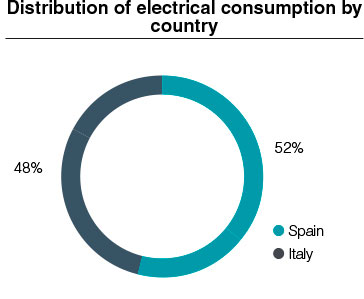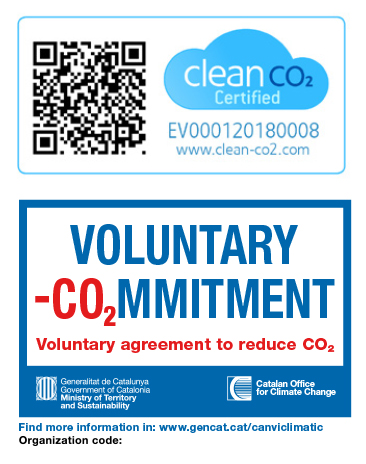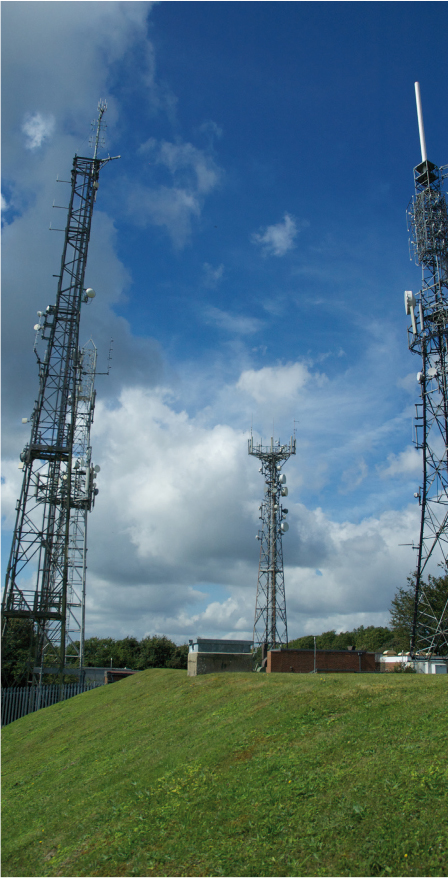Environment
Responsible environmental management
Cellnex has an Environmental Policy based on respecting the environment, protecting and preserving biodiversity, using renewable energies, mitigation and adaptation to climate change, and contributing to sustainable development through the efficient use of resources, as well as promoting preventive and mobility actions.
Thus, not only does Cellnex base its activity on the principles of sustainability and responsibility, but has also defined Sustainable Business Development as one of the basic pillars of its CR Master Plan. This involves the company committing to sustainability, environmental preservation and efficiency by setting goals, and more specifically by implementing concrete actions and programmes for all the companies of the Group.
Within the organisation's environmental objectives defined in 2017, there were 26 goals established for improving or mitigating environmental impacts. Sixteen of these have been implemented, and the rest are almost implemented or in the process of completion.
The Sustainable Business Development pillar is defined on the basis of the following goals, each of which consists of several specific actions:
- Putting environmental management of Cellnex in Spain at the same level as the rest of the companies in the Cellnex group;
- Promoting Energy Efficiency, increasing the use of renewable energy as much as possible and fostering the implementation of efficiency measures at the company's premises;
- Committing to sustainable mobility;
- Developing a carbon management framework in Spain to include the strategic perspectives to be worked on and focused on a set of actions, framed in different lines of management, that must be approved, funded and implemented to achieve the carbon management objectives established;
- Minimising the risks and fostering the business opportunities derived from climate change identified in relation to Cellnex Telecom's activity in Spain;
- Progressively reducing the carbon footprint in Spain and Italy;
- Protecting and respecting the ecosystems affected by Cellnex's activity;
- Promoting a sustainable culture within the Cellnex organisation; Measuring and communicating environmental performance and reporting this on an annual basis in international organisations (CDP, GRI, DJSI, UNGC, FSTE, etc.).
Monitoring and managing the main risks, opportunities and environmental impacts


Within the environmental management system already implemented and certified, Cellnex Spain periodically updates the identification and evaluation of its environmental aspects, risks and opportunities related to the company's activity and its derived environmental impacts, as well as the significance criteria.
The most significant impacts are extracted from these evaluations, to which end a monitoring system is established and actions are associated to mitigating them.
Efficiency and management actions are performed according to the type of impact and are related to energy and biodiversity respectively.
During 2017, more efforts were put into communication and awareness-raising on environmental issues. Specifically, there was a campaign to adapt the signage to the new organisational design, focusing on certain specific issues such as loading and unloading diesel fuel and actions to be taken in emergency situations, identification of waste storage points using new posters, for centres declared as small waste producers by the Administrations and other issues related to the main environmental aspects of Cellnex Spain.
Energy
Cellnex monitors the Group’s energy consumption in order to achieve maximum efficiency and the lowest possible impact on the environment and hence on society. Cellnex attributes as internal energy consumption the energy consumed in all its operating centres and offices.
The company's electricity consumption in 2017 was 249,462,592 kWh in Spain and 228,397,315 kWh in Italy. Cellnex’ electric energy consumption intensity in Spain is 55,179 kWh per establishment (taking into account only those sites from which invoicing data is available).
Cellnex Spain has photovoltaic generation facilities and small-scale wind turbines at its own sites, which generated 68,744 kWh in 2017.

| Diesel consumption per country [kWh] |
|---|
|
|---|
| 2016 | 2017 |
|---|
| Spain | 9,497,843.25 | 8,968,860 |
| Italy | 3,480,185.68 | 3,494,767 |
| Total | 12,978,028.93 | 12,463,627 |
| Natural gas consumption (kWh) |
|---|
|
|---|
| 2017 |
|---|
| Spain | 13,413 |
| Italy | 0 |
| Total | 13,413 |
Energy efficiency
Throughout 2017, Cellnex continued working to achieve more efficient procedures and perform initiatives to reduce energy consumption. This objective focuses primarily on improving equipment and implementing technologies that increase efficiency, applied in two different approaches: products and services provided by the company and Cellnex's own offices and centres.
The most relevant projects in 2017 were:
- Installation of wall and ceiling fans in On Tower centers with compact air conditioning working as free coolants.
- Implementation of several specific projects in Collserolas Tower to achieve savings in energy consumption such as: installation of a solar filter on all glazed surfaces to improve the enclosures, replacement of the current lighting system (fluorescent) by LED lighting, installation of monitoring and thermal control systems and recorders for the automatic activation of the climate and recording of consumptions of the equipment and transfer of transformers to rooms that do not require air conditioning.
- Replacement of separator transformers by passive protections without losses against transient and permanent voltages in some Cellnex centers.
Alticom has become one of the most sustainable Data Centre providers in the Netherlands thanks to the energy efficiency measures implemented in refrigeration systems.
Efficiency projects have made it possible to avoid 100,773 kWh, representing 35.2 Tn eq CO2 in 2017.
GRI: 305-5, management approach for energy (103-1, 103-2, 103-3), 302-1, 302-2, 302-4
Carbon footprint
Cellnex has made a great and continuous effort to roll out policies and practices to comply with sustainability and environmental commitments. Cellnex's Environmental Policy is based on respect for the environment, protecting biodiversity, using renewable energies, mitigation and adaptation to climate change, and contributing to sustainable development. These principles are unavoidable in all of the organisation's activity. The company ensures that it can achieve these goals through efficient use of resources and promoting preventive and mobility actions. During 2017, Cellnex Spain updated its environmental policy based on the foregoing. Within this policy, it has initiated the Cellnex Carbon Management Plan in Spain, which will define the specific actions and their prioritisation over time and will be created in three phases. The first two phases were addressed during 2017, consisting of an initial diagnosis and analysis of risks and opportunities of climate change in Cellnex's activity, and beginning to define and prepare the Cellnex Carbon Management Plan. There are plans to finish defining the Plan during 2018 and to have it presented to and approved by Management, in addition to setting a schedule for implementation.
As every year, Cellnex has had the carbon footprint of its business in Spain and Italy measured and verified by an independent third party. This initiative makes it possible to gauge the company's impact on climate change and represents a starting point for managing and reducing its emissions.
In 2017, Cellnex Spain and Italy GHG emissions are calculated taking account the financial control approach. To that end, the organisational scope was calculated on the basis of the financial control criterion for the corporate premises and technicians of the Cellnex Spain: Tradia, Retevisión and OnTower and in the case of Cellnex Italy: Galata and TowerCo.
The operational scope is based on the following criteria:
- Scope 1: covers GHG emissions that are directly under Cellnex control.
- Scope 2:iIndirect emissions from its activity but generated by other entities, including emissions from the generation of electricity and consumption by the company.
- Scope 3: takes into account indirect GHG emissions resulting from the organisation's activities but which are generated in sources owned or controlled by another organisation. For the calculation of scope 3 emissions the following categories have been included according to the "Corporate Accounting and Reporting standard (scope 3)"
- Purchased of goods and services: emissions resulting from water consumption and paper consumption.
- Upstream transport and distribution resulting from trips made by third parties paid by Cellnex by road, plane and / or sea.
- Generation of waste: missions associated to the management of waste fractions that have a contribution greater than 1%.
- Business travel: emissions resulting from trips by plane of Cellnex staff, taking into account the characteristics of the flights.
End of life treatment of sold products: waste management once the useful life of the product has ended, and which represent at least 1% of the total taking into account that the sum of those not included does not exceed 5% of the total.
GRI: enfoque de gestión de emisiones (103-1, 103-2, 103-3)
As part of its efforts to manage greenhouse gas emissions, in 2017 Cellnex in Spain compensated 2,420 tCO2 by purchasing 2,420 VER (Verified Emissions Reductions) credits on the voluntary market from the Blumenthal Project developed in Germany, with the Verified Carbon Standard (VCS), to achieve neutrality in Scope 1 carbon footprint emissions.
From a communication and awareness-raising point of view, the company has released several communications of its actions:
- Publication of the company's carbon footprint report on the Cellnex corporate website.
- Registration in the Footprint Registry of the Spanish Climate Change Office under the Ministry of Agriculture, Food and Environment.
- Joining the Catalan Generalitat's Voluntary Agreements Programme for reducing greenhouse gas (GHG) emissions. This tool is promoted by the Catalan Office for Climate Change (OCCC) for companies seeking a voluntary commitment to reduce their GHG emissions beyond what regulations stipulate.

- Publication of the withdrawal of the carbon credits from the project selected in the Market Environmental Registry or equivalent as a guarantee of the compensation made.
- Participation in the coproduction together with the City Council of Barcelona of the Clima Plan of Barcelona, that centralizes all the in curs or planned actions related with climate change taking part in the city. Cellnex develops proposals at a company level and takes part in the debate of the recopilation of the received proposals from the participants.

GRI: management approach for biodiversity (103-1, 103-2, 103-3), 304-2, management approach for emissions (103-1, 103-2, 103-3), 305-1, 305-2, 305-3
Biodiversity

As part of the evaluation and monitoring of Cellnex's aspects and impacts, the organisation has identified loss of biodiversity and the environmental impact on living beings and natural species considered as significant in this regard. As regards indirect impacts, Cellnex has identified ensuring the correct final management of waste associated with suppliers, as well as ensuring the environmental responsibilities of its suppliers to avoid impacting and affecting the biodiversity within the facilities. Cellnex manages its facilities to minimise any environmental impact to meet its objective of preserving biodiversity.
To ensure a proper management of these impacts, it is essential to have a diagnosis of the presence of Cellnex's activity in areas with greater vulnerability. Specifically, in Spain 57.5% of the sites are within protected areas, while in Italy this figure is 19.6%. Likewise, it has been identified that maintenance tasks are the activities with the greatest potential environmental impact. Given that maintenance activities are carried out through subcontracted companies, Cellnex requires suppliers to apply best practices in terms of environmentally safe operations.
During 2017, mitigation of biodiversity loss was enhanced with the creation of new signs on the identification of centres with Bird Nesting to know whether a centre does in fact cause such an effect and to remind staff of the preventive measures to be taken into account.
DaMA programme
Cellnex uses the DaMA (environmental data server) tool to display geographical data and identify declared natural protection sites in the country, information that is also found in the GESEM database. The server also provides access to environmental data relating to Cellnex Spain's sites.
Electromagnetic emissions
Cellnex Telecom complies with the rules associated with electromagnetic emissions for the general public and its workers. It conducts periodic measurements at technical centres with a permanent staff presence. As regards the general public, it ensures compliance with Royal Decree 1066/2001 at all sites in Spain.
The current situation in Italy involves a stricter regulatory framework, with limitation levels lower than in Spain. Likewise, Cellnex Italy is working towards ensuring compliance.
GRI: 416-1, management approach for biodiversity (103-1, 103-2, 103-3), 304-1, 304-2







